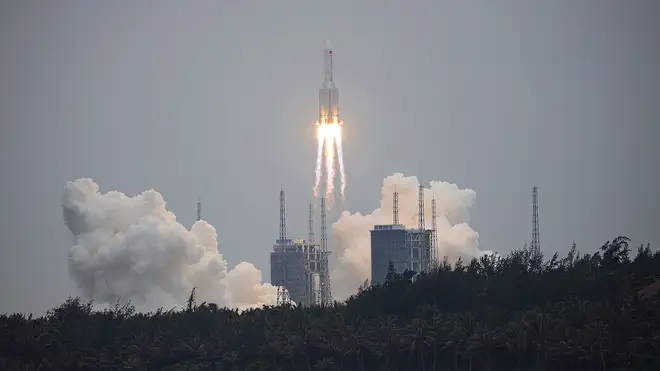
James O'Brien 10am - 1pm
7 May 2021, 10:44

A section of the rocket is expected to plunge back to Earth this weekend at an unknown location.
China says the upper stage of its Long March 5B rocket that launched the core module of its space station will mostly burn up on re-entry, posing little threat to people and property on the ground.
Foreign Ministry spokesman Wang Wenbing said Chinese authorities will release information about the re-entry of the rocket, expected over the weekend, in a “timely manner”.
He said China “pays great attention to the re-entry of the upper stage of the rocket into the atmosphere”.
“As far as I understand, this type of rocket adopts a special technical design, and the vast majority of the devices will be burnt up and destructed during the re-entry process, which has a very low probability of causing harm to aviation activities and the ground,” Mr Wang said.
The largest section of the rocket that launched the main module of China’s first permanent space station is expected to plunge back to Earth as early as Saturday at an unknown location.

Discarded rocket stages usually re-enter the atmosphere soon after lift-off, normally over water, and do not go into orbit.
China’s space agency has yet to say whether the main stage of the huge Long March 5B rocket is being controlled or will make an out-of-control descent.
Last May, another Chinese rocket fell uncontrolled into the Atlantic Ocean off west Africa.
The Communist Party newspaper Global Times said the stage’s “thin-skinned” aluminium-alloy exterior will easily burn up in the atmosphere, posing an extremely remote risk to people.
The US Defence Department expects the rocket stage to fall to Earth on Saturday, but the Pentagon said where it will hit “cannot be pinpointed until within hours of its re-entry”.
White House press secretary Jen Psaki said US Space Command was “aware of and tracking the location” of the rocket.
The Aerospace Corporation expects the debris to hit the Pacific near the Equator after passing over eastern US cities. Its orbit covers a stretch of the planet from New Zealand to Newfoundland.
The Long March 5B rocket carried the main module of Tianhe, or Heavenly Harmony, into orbit on April 29.
China plans 10 more launches to carry additional parts of the space station into orbit.
The roughly 100ft stage would be among the biggest space debris to fall to Earth.
The 18-ton rocket that fell last May was the heaviest to fall uncontrolled since the former Soviet space station Salyut 7 in 1991.
China’s first space station, Tiangong-1, crashed into the Pacific Ocean in 2016 after Beijing confirmed it had lost control.
In 2019, the space agency controlled the demolition of its second station, Tiangong-2, in the atmosphere.
In March, debris from a Falcon 9 rocket launched by US aeronautics company SpaceX fell to Earth in Washington state and on the Oregon coast.